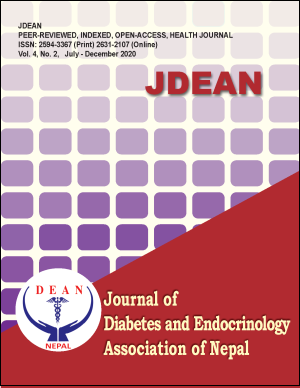Use of complementary and alternative medicine in Type 2 Diabetes in Eastern Nepal
DOI:
https://doi.org/10.3126/jdean.v4i2.34590Keywords:
Complementary and Alternative medicines (CAMs), Type 2 DiabetesAbstract
Background: The chronic and progressive nature of Diabetes Mellitus often leads people to use complementary and alternative medicines (CAMs) which may be defined as a group of medical and health care systems, practices and products that are not considered to be part of conventional medicine.
Methods: This descriptive cross-sectional study was done in a tertiary care hospital in Eastern Nepal from 15th June 2018 to 15th September 2019 to determine proportion of type 2 diabetic patients who have tried complementary and alternative medicines (CAMs) exclusively prior to presentation to endocrine OPD (Outpatient department). Consecutive sampling was done after informed verbal consent.
Results: Out of 401 participants, 60.6 percent were male and 39.4 percent were female. Mean age of participants was 52.21 ± 11.42 years. Regarding use of CAMs, 11 percent sad tried some form of CAMs exclusively without any allopathic antidiabetic medicines for some period in their lifetime prior to presentation to endocrine OPD. More specifically, 10.3 percent had tried products under brand of ayurvedic medicines from local practitioners. Similarly, 0.2 percent had tried medicine from Homeopathic Practitioner and rest (0.5 percent) had tried homemade herbal remedies like garlic, fenugreek, aloe vera and bitter melon.
Conclusion: A significant proportion of type 2 diabetics in our community are still using CAMs. The associated factors behind this and long term effects of such products in diabetic patients need to be explored further in details.
Downloads
Downloads
Published
How to Cite
Issue
Section
License
This license enables reusers to distribute, remix, adapt, and build upon the material in any medium or format for non-commercial purposes only, and only so long as attribution is given to the creator.




